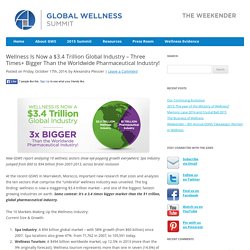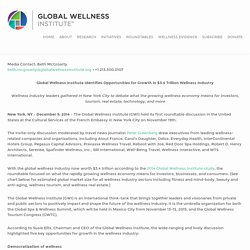

Wellness Is Now a $3.4 Trillion Global Industry – Three Times+ Bigger Than the Worldwide Pharmaceutical Industry! New GSWS report analyzing 10 wellness sectors show eye-popping growth everywhere; Spa industry jumped from $60 to $94 billion from 2007-2013, across brutal recession At the recent GSWS in Marrakesh, Morocco, important new research that sizes and analyzes the ten sectors that comprise the “umbrella” wellness industry was unveiled.

The big finding: wellness is now a staggering $3.4 trillion market – and one of the biggest, fastest-growing industries on earth. Some context: it’s a 3.4 times bigger market than the $1 trillion, global pharmaceutical industry. The 10 Markets Making Up the Wellness Industry: Current Size & Growth: Spa Industry: A $94 billion global market – with 58% growth (from $60 billion) since 2007. Dr. More detailed, regional data on the spa, wellness tourism and hot springs markets will be broken out in upcoming Weekenders. DOWNLOAD FULL REPORT: We encourage everyone to download the full, 50-page report, to access the detailed data.
The Health & Wellness Market is the Next Trillion Dollar Industry. Women’s Marketing recently collaborated with Rodale on original consumer research designed to explore and explain the modern “Health & Wellness” consumer mindset and delve into 2014 wellness trends.

Wellness, defined as the quality or state of being healthy in body and mind, especially as the result of deliberate effort, is a mindset we believe has seeped into the lives of the everyday woman, and has emerged as a lifestyle here to stay. Which Product Categories Account for the Increasing Wellness Market Size? There are several common threads that stand out across the various definitions of wellness. Wellness is multi-dimensional, holistic, changes over time and along a continuum, and is most importantly individual, but also influenced by the environment and community. The Seven Top Competitive Strategies For Health & Wellness Businesses. Are you totally clear on how your wellness business will successfully compete?

Or do you mostly try not to think about it? You’ve got seven competitive alternatives to choose from: 1) Toe to toe You think your wellness programs are unique – and then you find out that your competition looks just like your business – same services, same prices, same target customer, same sales and marketing strategies. Happens a lot. Oops. The health club or yoga studio with the deepest pockets will outlast their competitors. Example: all the yoga and Pilates studios that close within the first year, outgunned by a bigger studio. 2) Overwhelming force Focus on your single greatest competitive advantage. Is there a particular type of problem that you solve better than anyone else? Whatever it is, center everything – EVERYTHING – you do around capitalizing on that advantage. Example: Amazon started selling books.
Zappos started out selling shoes. 3) Strength in numbers Don’t go it alone.
Green is the new black: the unstoppable rise of the healthy-eating guru. Nestled among stuffy interior decorating and antique shops, Daylesford farmshop and cafe in Pimlico is, judging by the queue on a weekday mid-afternoon, very much the chic place to meet for a fresh vegetable juice (£6) or a superfood salad (£14).

A decade ago, you’d have struggled to find a place such as this in London; now, there seems to be one opening every other day. But, as one review warns, everyone at Daylesford “is likely to be thinner, blonder and richer than you”, and I can testify that this much is true. It is part of a chain owned by Carole Bamford, a woman described on her website as “a visionary in organic farming and healthy food retailing”.
She is also the wife of Anthony Bamford, director of the JCB construction empire, although here in the farm shop the emphasis is very much on organic spelt bread rather than hydraulic excavators. Despite having had her third child four months ago at the age of 40, Avansino is very slim. I was wrong.
Health and Wellness the Trillion Dollar Industry in 2017. Strong recovery of the global health and wellness market is on the way, with sales recording 6.5% value growth (fixed exchange rates) in 2011.

Products offering specific health benefits, such as fortified/functional, or those renowned for their natural health properties drove value sales, with rates above 7%. Growth was further fuelled by the developments in the emerging markets as China and Brazil alone contributed US$15 billion in new sales that year. Steady real term growth of 7.2% (current prices) is expected to continue to 2017, with global health and wellness sales on the way to hit a record high of US$1 trillion by 2017. Changing Future of Consumer Health & Wellness Industry.
GWI Identifies Opportunities for Growth in $3.4 Trillion Wellness Industry — Global Wellness Institute. Media Contact: Beth McGroartybeth.mcgroarty@globalwellnessinstitute.org • +1.213.300.0107.
